Samsung Galaxy Note 8.0 Review
by Anand Lal Shimpi on April 17, 2013 11:29 PM EST- Posted in
- Tablets
- Samsung
- Android
- Mobile
- Galaxy Note 8.0
GPU Performance
The GPU side of Samsung's Exynos 4 Quad is also powered by ARM, in this case we're talking about the Mali 400MP4. ARM's Mali 400 is also getting older, but when it arrived on the scene its performance was pretty respectable. To evaluate its performance, we turn to our recently expanded list of Android 3D benchmarks starting with 3DMark.
3DMark - Ice Storm
3DMark for Android features the Ice Storm benchmark and uses OpenGL ES 2.0. Ice Storm is divided into two graphics tests and a physics test. The first graphics test is geometry heavy while the second test is more pixel shader intensive. The physics test, as you might guess, is CPU bound and multithreaded. The overall score takes into account both graphics and physics tests. The benchmark is rendered to an offscreen buffer at 720p/1080p and then scaled up to the native resolution of the device being tested. This is a very similar approach we've seen by game developers to avoid rendering at native resolution on some of the ultra high resolution tablets. The beauty of 3DMark's approach here is the fact that all results are comparable, regardless of a device's native resolution. The downside is we don't get a good idea of how some of the ultra high resolution tablets would behave with these workloads running at their native (> 1080p) resolutions.
For these benchmarks we stuck with the default presets (720p, normal quality). I'm reporting the overall and physics scores here:
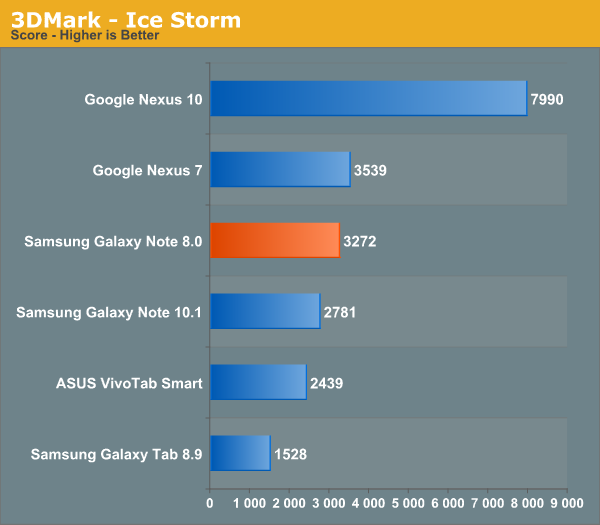
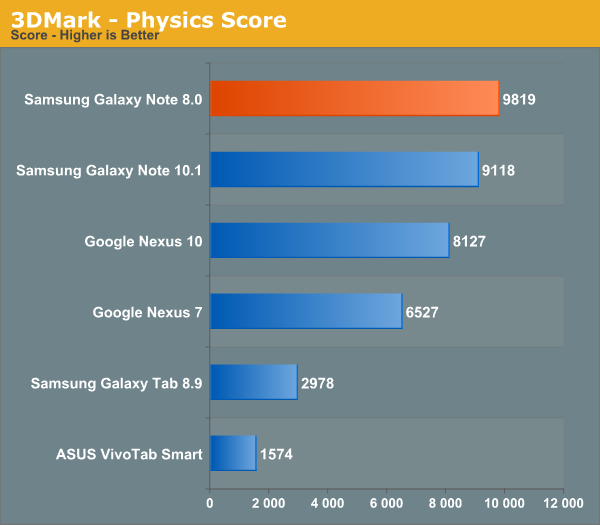
I tossed the physics test in here because it serves as an interesting multithreaded CPU benchmark. The results are largely unrealistic (a pair of Cortex A15s should almost always be quicker than four Cortex A9s at a lower frequency in most real world Android apps), but it does highlight the combination of core count and clock speed upgrades that we've seen over the past 2 years in the mobile tablet space.
Basemark X
Basemark X is a new addition to our mobile GPU benchmark suite. There are no low level tests here, just some game simulation tests run at both onscreen (device resolution) and offscreen (1080p, no vsync) settings. The scene complexity is far closer to GLBenchmark 2.7 than the new 3DMark Ice Storm benchmark, so frame rates are pretty low:
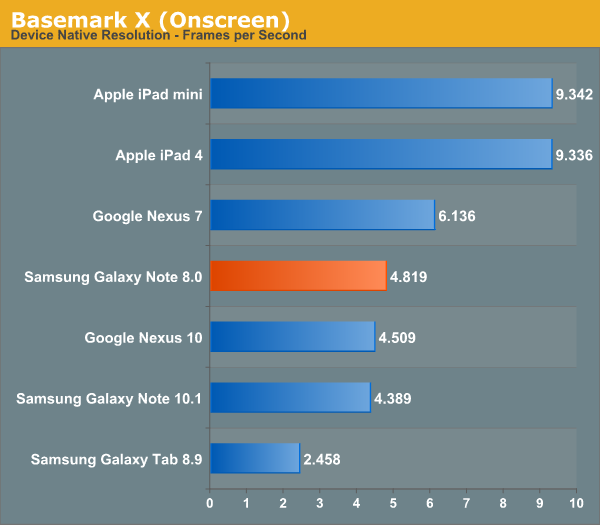
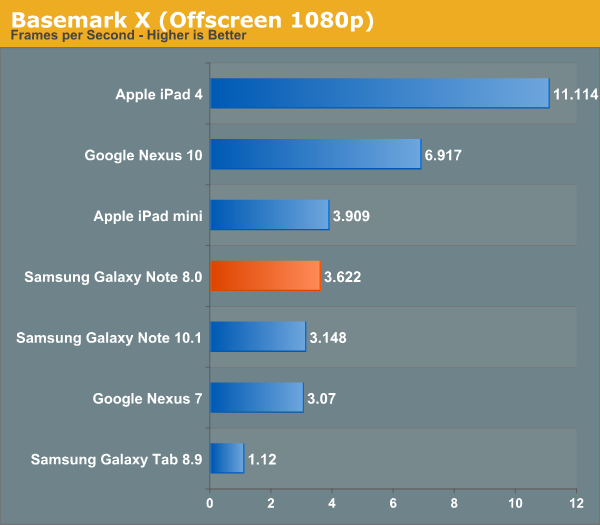
Basemark puts the Galaxy Note 8.0 behind the iPad mini in GPU performance and roughly 2 - 3x the performance of the Galaxy Tab 8.9.
GLBenchmark 2.7
GLBenchmark 2.7 gives us some low level results to look at. We'll start with peak theoretical fill rate and triangle throughput tests:

The Mali 400MP4 in the Galaxy Note 8.0 is capable of delivering similar fill rate to the PowerVR SGX 543MP2 in Apple's iPad mini, but the latter still holds an appreciable performance advantage. The gap between the 8.0 and 10.1 Galaxy Note models boils down to clock speeds. Compared to the old Galaxy Tab 8.9, the Note 8.0 puts its spiritual predecessor to shame.
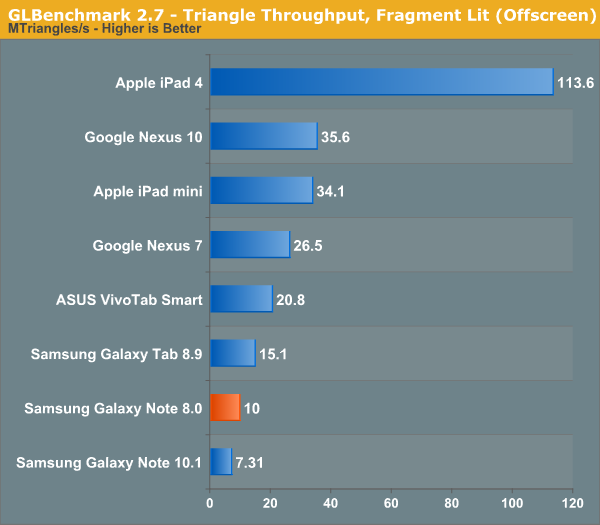
Can anyone say regression? ARM's Mali 400MP4 was never very strong from a triangle throughput standpoint, technically the Galaxy Tab 8.9 is quicker here (although you'll pretty much never see it surface in an actual game). The two GLBenchmark 2.7 test scenes follow:
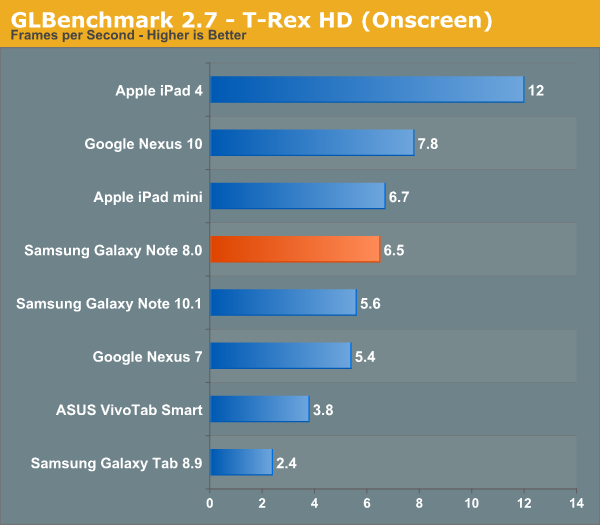

GLBench puts the Note 8's overall performance just slightly behind that of the iPad mini, and ahead of the mini if you compare identical workloads (offscreen 1080p). Obviously the GPU included here isn't anywhere near powerful enough to run the T-Rex HD workload at reasonable performance levels, but I wouldn't expect that to really hamper gaming performance for at least another two years.
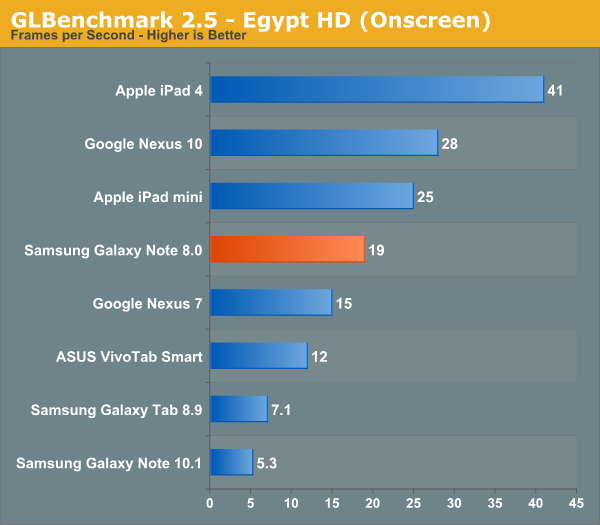
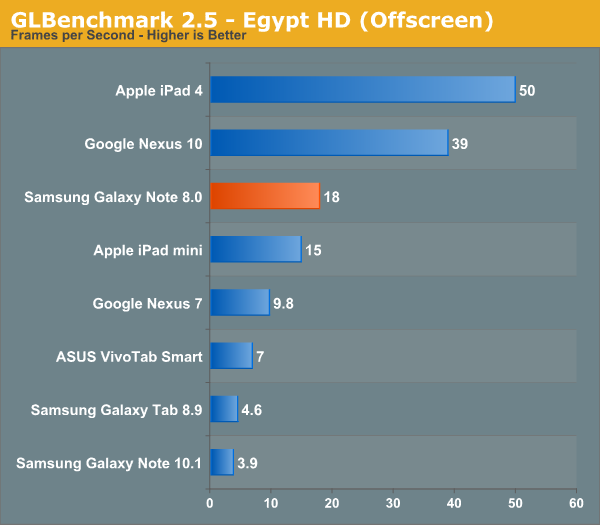
Egypt HD gives us a better look at what performance will look like in the near term. Once again, at native device resolution the iPad mini does better than the Note 8.0 but with the same workload/resolution their roles reverse. What we usually see, regardless of capabilities, is good real world performance by pretty much anything on the market. Most game developers seem to treat modern tablets like game consoles and attempt to deliver a good experience across the lowest common denominator rather than targeting the absolute high end.










95 Comments
View All Comments
nerd1 - Thursday, April 18, 2013 - link
I think it's better than most people need - it exceeds ipad mini in almost every aspects (except for 10% less battery life) and I think wacom pen + multi-window support is very crucial for many circumstances, like searching for something in one window and writing down a note in the other window.nerd1 - Thursday, April 18, 2013 - link
Also I think it is very absurd that just everyone ignores the micro SD slot when comparing prices. You can get 16GB one and put 32GB or 64GB micro SD to upgrade the storage, and most will do because it is way cheaper, which Nexus or iDevices cannot.steven75 - Thursday, April 18, 2013 - link
It still falls down in one massive area that all Android tablets fall down in: app ecosystem.extide - Thursday, April 18, 2013 - link
Apple fanboy much? lolNekoTipcat - Thursday, April 18, 2013 - link
Ipad mini wins in 2 aspects or 31 Battery
2 GPU
3 iOS (if you like it)
Spunjji - Friday, April 19, 2013 - link
Samsung Note 8.0 wins in 2 aspects or 31 Pen
2 CPU
3 Android (if you like it)
...sorry, I really couldn't resist.
FlyBri - Thursday, April 18, 2013 - link
Anand -- I see you mention that the Galaxy Note 8.0 has a PLS display, but I have seen other information that states the display is a TFT panel. Could you provide some more color on this? Thanks!B3an - Thursday, April 18, 2013 - link
... Err TFT stands for Thin-Film-Transistor. All LCD displays are TFT."TFT LCD" is the general technology and theres many different types of panels for it. PLS is one of them types. The Galaxy Note 8.0 uses PLS which is one of the best kinds of TFT LCD panels.
Sabresiberian - Thursday, April 18, 2013 - link
"PLS" is Samsung's version if LG's "IPS". :)Whether or not it is better - well, there are different versions of both technologies, and Samsung's PLS is newer and so they are still improving it. I would judge on a product-by-product basis.
FlyBri - Thursday, April 18, 2013 - link
My bad, I meant TN, not TFT -- brain fart. In any case, if it's PLS, that's good, but the thing is still overpriced...